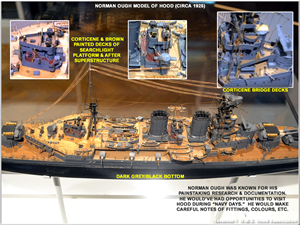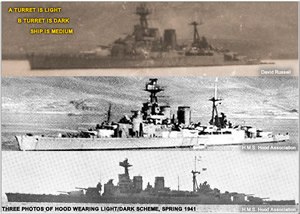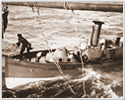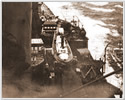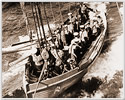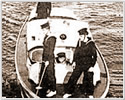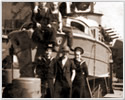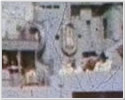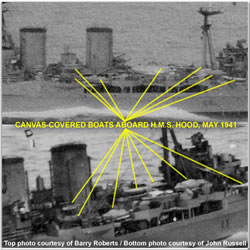Research Background
For this article, we've done the research so you don't have to. Even so, some of you will undoubtedly wish to learn more or even conduct your own research. With that in mind, we can highly recommend the following link for excellent background information concerning Royal Navy colours and paint schemes: Original Research (Sovereign Hobbies) and HMS_Hood.pdf (shopify.com)
Getting Started
Hood wore derivatives/variations of two very basic paint shades/schemes during her 21 year career, and this largely depended on where she was assigned. Therefore, before you can paint your model or colour your artwork, you first need to determine when you are modeling the ship. Specifically, what time frame, configuration or specific event is the model is to represent? Once you know this, simply select from the desired time range/period listed (in green) below.
Important Things to Remember
We advise modellers and artists to follow these instructions if they wish to avoid some of the most common Hood-related painting mistakes. With this in mind, we ask you to pay heed to or at least be aware of the following:
1. ITS YOUR MODEL, YOU MAKE THE DECISIONS! Our intent is to help people create accurate renditions of Hood. Despite this, don't feel that you have to do everything we (or others) recommend. There are far too many "rivet counters" out there on the World Wide Web. Its YOUR model and its your choice to do as you please. You are certainly welcome to employ some "artistic license" here and there. As long as YOU are happy with your work, that's ALL that counts! If, however you wish to be as accurate as possible, please read on!
2. Please do not rely solely upon kit painting instructions, photos of completed models or paintings/artwork. One can never be sure of the level of research conducted, or, the degree of accuracy imparted into the final product. This even applies to the models and paintings we feature on our own web site - these items aren't displayed necessarily because of accuracy, but simply because they depict Hood. Our goal is not to judge people's work, but to encourage modelling and creation of artwork of Hood.
3. Please do not "guesstimate" colours from old black & white photos. This is because there are numerous factors which tend to make film unreliable: First is the type of film that was used. Orthochromatic film was sensitive to bluish light. As a result, when processed, blues tended to look lighter and reds tended to look darker. Panchromatic films were more balanced, but the problem is that we have no way of positively knowing what film type was used for old photos. The matter becomes even more complicated when one considers additional factors such as the reflective/absorption properties of the ship's paint(s), weather/environment/lighting, the camera's settings, original development/processing work and later scanning and processing work! The result is that a "paint job" could look much lighter or darker than it actually was. So, judging precise colours from black and white photos is often an exercise in futility.
4. Colour footage is not always precisely accurate. Old colour footage also had its share of issues. It too is affected by film stock, camera settings, the environment, original processing/developing, age and of course modern scanning/transfer and digital processing. Indeed these latter items can be particularly problematic. For an example of processing gone wrong, simply view this over-processed image of Hood. She's far too light (and too blue)!
5. Don't assume paint or adherence to directives/orders was always spot-on. While its true that the Admiralty had exacting specifications for paint and issued directives with regard to appearance, etc., it didn't mean that things were always followed to the letter. The real world had a way of interfering: First, paint stocks could vary from depot-to-depot and ship-to-ship. This meant that sailors often had to make-do and/or improvised somewhat with whatever was on-hand or could be appropriated. Second, sometimes painting was done in sections or as patch-up work. Third, Hood was a very busy command ship and what was done depended on her schedule...and the preferences of her commanding admiral/staff. So, what you see in one photo may look different than what you see in another and just because the Navy issued orders to do one thing, it may have been done slightly differently in reality. In short, no matter how well you research things or mix your paint, its unlikely you'll ever make things look exactly as they were.
6. Not all areas of Hood are well documented. We cannot stress this enough. Even WE keep learning more about her as time goes on! This means we periodically have to update this and other articles. Yes, Hood was/is famous but that doesn't mean that everything about her was recorded or remembered! This is particularly true for the wartime years. As a result, it is nearly impossible, even for us, to correctly identify the exact colour of every object on the ship. Because of this, there may be some hypothetical assessments involved (in other words an educated guess). If we are not 100% certain of something, we will let you know in the text below. When and if new information does come to light, we always try to update this article accordingly.
7. Have realistic expectations. As the items above have demonstrated, its unlikely that anyone can truly ever create a 100% precise rendition of Hood. There are simply too many complicating factors. One can get "close" though (if one wishes).
Colour Scheme Specifics
I. 1920 - June 1936 & June 1939 - Early 1941: Dark Grey (Home Fleet Shade)
Hood was painted in the Royal Navy's Home Fleet standard dark grey shade for the bulk of her service. During the first few years of her career, this was a pure dark grey. The formula was changed in the mid 1920s to include a tinge of blue. The paint was somewhat glossy during peacetime years due to the inclusion of enamel. A matte variation of the colour (known as Pattern 507A) was introduced around the start of the Second World War. This variation was less reflective than the standard 507B which it ultimately replaced.
Regardless of official designation, Hood wore the contemporary versions of the Home Fleet dark grey colour for her entire career except for her 1936-1939 assignment with the Mediterranean Fleet. Unless specifically called out below, the colours of the features in question are applicable for the entire timeframe.
Suggested paint match: The following are matches for the Home Fleet Grey in use during most of the inter-war and early war years (exact or close directly from the bottle). This list is alphabetically sorted and contains both enamels and acrylics. You may be able to find some of these locally or through a preferred retailer of your choice:
- Lifecolor Admiralty Dark Grey 507 A (UA631)
- Sovereign Hobbies Colourcoats NARN07 - Late 1920s to 1936 Interwar Home Fleet Dark Grey; 507B (best possible match for late 1920s-1936)
- Sovereign Hobbies Colourcoats NARN20 - 1936-1943 Home Fleet Grey 507A / 507B 13% RF or Sovereign Hobbies Colourcoats NARN21 - 1936 to early 1950s - Home Fleet Grey 507A / G10 10% RF (best possible match for 1939-1940)
- Testors Model Master 4879 - 507-A Dark Gray R.N. (acrylic)
- Testors Model Master 2169 - 507 A Dark Gray R.N. Semi-Gloss 1/2oz (enamel)
Click the following to enlarge:
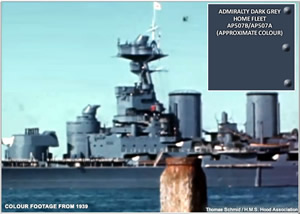
Above - Colour footage of Hood from late 1939.
Note the contrast between the overall dark
grey, the white foretop mast and the portside
red signal light.
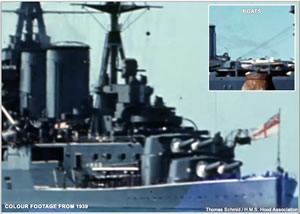
Above - Another view from 1939. Here, one can
see the extreme contrast between the dark grey
and things such as blast bags and White Ensign.
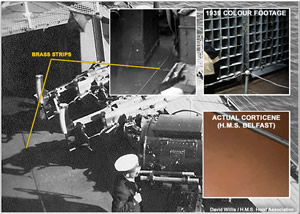
Above:
Corticene on bridge (1934 and 1939).
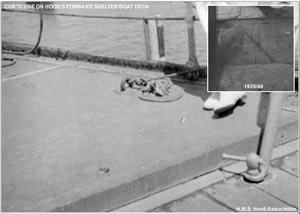
Above:
Corticene on Shelter Deck (1938).
- Wooden Decks: Unpainted teak (medium shade - a cross between honey and tan during peacetime, duller during the war years). This includes the focsle (bow), side batteries (the area under the boat deck), the boat deck and the entire quarterdeck (stern).
- Pre-war years- The decks were very clean and bright due to frequent holystoning (scrubbing). To quote some veterans, the decks were "clean enough to eat off of." Some metal deck fittings (fairleads, vents, skylights, hatches, etc.) would be hull colour, but others, such as bits and bollards, would be black. It should be possible to replicate the proper wood tone using paint such as Sovereign Hobbies Colourcoats C01 Teak or Tamiya XF-78 Wood Deck Tan as a base. Another option open to modellers are wood deck veneers. These can look a bit out of scale, but when done right, look quite nice.
- Wartime years- From 1940 on, its likely she would have had her decks dulled down. They should also have been darkened, but both colour and black & white footage (as well as the wreck itself) show this not to be the case. The deck was duller, but no darker. It was certainly never over painted. Bits and bollards remained black and other features remained hull colour.
- Bridge Decks: As built, all bridge decks were covered with corticene/corticine, a cork-based linoleum of a brown hue. This remained in place on the bottom two decks for her entire career. We do not know what was used for the upper bridge decks that were expanded or added later: its quite possible/likely, that these too were covered with corticene to match the other decks (through continuity of use). There is a possibility (not confirmed) that some sections could have been partially or entirely coated with a non-slip coating such as semtex (a paste-like substance that hardened into an extremely gritty coating) or non-slip paint could have been used.
- Corticene would become worn and dingy over time when outdoors. Colour footage of Hood from 1939 bears this out. Of course, corticene was periodically renewed/replaced. A good colour match for fresh corticene would be Sovereign Hobbies Colourcoats NARN44 Corticene or Tamiya XF-79 Linoleum Deck Brown or Lifecolor Corticene (UA642).
- Semtex came in light grey, brown or green during Hood's service. Semtex was known to get darker and dingy due to its gritty/textured nature. Its difficult to judge the color of Hood's semtex. It appears to be either a dirty grey or brownish in the famous 1939 colour film. In black and white photos, the semtex areas are similar in tone to the wooden deck, lighter than corticene and lighter than the dark grey vertical structures.
- Non-slip paint (IF it was actually used aboard Hood is UNKNOWN) is best matched by Sovereign Hobbies Colourcoats NARN23 - WW2 Dark Grey Non-Slip Deck Paint
- Corticene would become worn and dingy over time when outdoors. Colour footage of Hood from 1939 bears this out. Of course, corticene was periodically renewed/replaced. A good colour match for fresh corticene would be Sovereign Hobbies Colourcoats NARN44 Corticene or Tamiya XF-79 Linoleum Deck Brown or Lifecolor Corticene (UA642).
- Forward and outer portions (un-planked) Shelter/Boat Deck: The exact coverings used varied during her career:
- 1920-Late 1937 - The non-wood portions of the deck were entirely covered with corticene.
- 1937-1940- This deck was was widened/expanded in December 1937. Semtex was applied to the new areas (per ADM136/13, Part 3, semtex was applied specifically to the "covered working space of 4" H. A. Guns at Stations 161-205 port & starboard"). The original areas remained covered with corticene.
- 1940-As Sunk - There is some evidence to suggest that SOME of the shelter deck corticene was replaced with additional semtex (colour unknown) in 1940. It appears that the outer areas (under the UP launchers and forward 4" guns) had the semtex, but the area inboard (around the funnels) retained corticene. Photographic coverage during this time period is scant and we will continue to refine this as more data comes to light.
- Painted Horizontal Surfaces (Deck Houses, Large Vents, Searchlight Platforms, etc.): Some horizontal surfaces (those that were not exposed to foot traffic) were painted hull colour. Other areas (turret tops, top of conning tower, etc.) were painted dark matte grey.
- The horizontal areas that were exposed to foot traffic (Searchlight platforms, etc.) are known to have been coated with a darker toned covering. Some have interpreted this as being dark grey (in keeping with perceived/assumed Royal Navy practice), but the 1939 colour film shows that some of these areas may have been painted brown in a tone similar to corticene (or possibly a Van Dyke brown). We also see a similar brown used on one or two contemporary models from the mid 1920s/30s (to include one built by renowned model maker Norman Ough, who was meticulous with research). We do not know if the colour changed by 1941. As such, areas such as the searchlight platforms and "Aunty" pom-pom's bandstand were either corticene, dark brown or dark grey (WW2 Dark Grey Non-Slip Deck Paint). This author leans towards brown through continuity of use.
- Foremast: As launched, the foremast, starfish and foretop mast were hull coloured. This was changed in the late 1920s or early 1930s. At that point, the upper portion of the tripod mast up to and including the starfish platform was painted black. The foretopmast was painted white (to avoid standing out on the horizon). Here are some key time frames:
- Empire Cruise (1923-24) - Then entire foremast (legs, starfish and fore top mast) were all hull coloured.
- 1931 Refit - The upper portion of the tripod up to and including the starfish platform were black.
- Wartime/As Sunk- The upper portion of the tripod legs and starfish platform were black.
- Mainmast: This also varied in colour throughout Hood's career. At times it was entirely hull coloured. At other times it was black from point where the three legs of the mast met up to the top of the starfish platform. There was also a white stripe which encircled the lowest portion of back (sometimes it encompassed all three legs, sometimes only the rear legs. The actual mast top (the part attached to the rear of the starfish platform and extending upward was generally white, but was also hull colour at various times. The white became more prevalent as it helped the masts from standing out on the horizon..
- Empire Cruise (1923-24) - Then entire mainmast (legs, starfish and top mast) were all hull coloured.
- 1931 Refit - The point where the legs met up to and including the starfish was black. The white stripe wrapped around all three legs.
- Wartime/As Sunk- The point where the legs met up to and including the starfish was black. The white stripe wrapped around all three legs.
- After Concentrating Position and Searchlight Platform: The decks were either dark brown (similar to corticene or Van Dyke brown) or non-slip dark grey. The colour film from 1939 suggests brown. Vertical surfaces were hull colour. There were large square windows which surrounded the lower rear walls of this structure. During Hood's early years, these were usually covered with stiff canvas (also painted hull colour). By the mid 1930s, these windows had been plated over and replaced with a couple of portholes/scuttles.
- Searchlights: Black or hull colour (1939 colour footage suggest they were hull coloured by that point in time).
- Funnels: Hull colour uptakes with very top "flange" and cage in black. The lower flanges around the base of each funnel varied, having been seen painted in hull colour or painted brown (possibly) or dark grey to match the metal decks.
- Main Guns: Hull colour (turret sides, rangefinders and barrels). The ends of the 15" gun barrels were emery polished to a bright metallic sheen during peacetime. Blast bags were bright white canvas. The colour of the turret tops/roof plates seemed to vary: We've seen photos where the tops were the same grey as the sides. We've also seen photos where the turret tops were dark deck grey or even black (they generally matched the colour of the painted metal decks). We've also seen a mix and match. To further confound things, we've also seen a pair of photos that show "Y" turret with its rangefinder painted the same dark grey as its roof!
- Empire Cruise (1923-24) - The gunhouse tops and associated flying off platforms were a darker grey than the hull colour.
- Wartime - Photos suggest that the turrets, gunhouses (including tops), blast bags and guns were hull coloured. The muzzles were also painted.
- Other Guns: Prior to roughly 1936 (when she was repainted to Mediterranean colours), Hood's secondary 5.5" and 4" guns generally had hull coloured bases/machinery/shields, but black or dark grey barrels. Their muzzles were also commonly polished to a bright metallic sheen. From 1939 onward, however, the barrels were hull coloured. Other guns, such as the 0.5" machine guns and pom poms, always had hull coloured mounts, but the actual guns were black.
- Cranes/booms: Main derrick was hull colour. It would appear that the other derrick booms and various boarding and hoisting booms were unpainted (though probably varnished) natural wood with painted metal fittings (hull colour).
- Ladders/Side Edges: The stairs/ladders leading to the Admiral's area just forward of "X" turret, had unpainted wooden hand railings. The edges of the bulwark along the ship's sides was unpainted wood.
- Waterline:The boot topping was generally glossy black (and about 8ft tall). If striving for ultimate realism, please note that rarely were boot toppings perfect, nor did they remain pristine; over time, the lower portion of the boot topping would have become somewhat faded and less distinct. So, if you choose to weather below the waterline, remember to also weather the boot topping to match. Reports of Hood's waterline and undercoating are filled with references to chipping, wearing and the presence of sea grass. See immediately below.
- Below Waterline: Surviving D495 Reports of Docking contained in ADM 136/13 (the ship's books) confirmed that everything under the waterline, to include the propeller shafts and rudder, was coated in Peacock & Buchan's anti-fouling paint (which was only supplied in grey and black). These reports rarely specify colour, but when they do, the only colour mentioned (at commissioning, in 1925 and again in the mid-late 1930s) is anti-fouling grey (an unspecified grey over a slate undercoating). We also have various photos of the ship in drydock at other periods of her career (for instance during her 1929-1931 refit and after her 1935 collision with Renown) and these clearly show the bottom to be lighter than the black boot topping. Therefore, we feel that its quite possible, based on continuity of use, that grey was likely her primary underside colour throughout her entire service. As for her final mission, a 22 May 1941 photo of the ship at sea shows a lighter shade below the black boot topping. The wreck itself (where the paint still remains) is a very dark grey/faded black below the waterline (but the general conditions/environment make it difficult to work out the exact shade).
Possible exception: Although grey seems to be the most used colour, we can't 100% rule out a black bottom for some periods. As it stands, we've seen no confirmed written official evidence of black being used, but we have seen some "circumstantial" evidence: there are a couple of contemporary models built around this time (one of which was by the renowned model builder Norman Ough and is currently housed in The Box museum) that show the ship with a black bottom. Additionally, certain photos of Hood taken during her Empire Cruise of 1923/24 also suggest that the bottom MAY have been black for this mission (at a light load the bottom appears similar in shade to the black boot topping...but its just barely visible).
The one thing we can state CONCLUSIVLEY is that Hood NEVER had a red bottom. Learn more about Hood's underside colour here (link to Sovereign Hobbies).
- Detailing Suggestion: Although she tended to have her bottom re-coated annually, the coating did get very worn over the course of the year. As a result, unless you are modelling Hood as "freshly painted" you might want to slightly lighten and/or weather the underside with a bit of slate grey or even black (to simulate her protective undercoating being exposed as the antifouling wore away). You can also add worn spots as well as chipping, barnacles and sea grasses if you so fancy.
Boats: For information on life boat colours, see Section IV, "Boats," near the end of this article.
- Special Notes:
1. During World War Two, Hood wore some sort of circular marking atop the centre of "A" gun house's roof. We've never been able to identify the precise colours nor purpose. Recollections by crew indicate that it may have been an aerial recognition marking. It may have been a roundel with a blue outer circle and red inner circle. This is unconfirmed. Photos of these marking can be seen above.
2. Support pillars in the enclosed focsle deck had white centres (see photo).
3. Stanchions for life rails were white at a point starting above the first cable/bar (see photo) during pre-war years. Also, the awning stanchions over the forward and aft ends of the ship were painted white.
4. Anchor cables were generally painted white during the pre-war years. They were dark grey or black during the war. The anchor cable capstans and hawse pipes were painted hull colour, but the actual anchor cable plates (that the chains ran along/sat upon) have been seen in hull colour and sometimes in dark grey or black.
5. The ship's name was polished brass during pre-war years and painted dark during the war.
6. During peacetime, the ship had a "kicking strip" painted around the lowest portion of vertical structures (where they met the deck). Examples of this are along the edges of the breakwaters and as a strip of paint along the lower portions of bulkheads/walls (similar to moulding one sees where floors and walls meet). The exact colour is not known, but based on recollections, it could have been black or darker grey. The height of this strip appears to have varied at different point in her service (i.e., in 1923/24 it appears to be over 1 foot in height. Other periods show something lower, closer perhaps to 6 inches). Wartime photos of the ship don't seem to show the kicking strip. Of course, at even the most common modelling scales, one would probably not see this trim effect.
7. Weathering would vary. For some periods (when she was not on cruises), the ship would have been very clean. At other times, such as during long cruises or wartime patrols, things were different. So, varying degrees of weathering (sometimes extreme) would be called for. More on this below.
II. June 1936 - June 1939: Pattern 507C - Light Grey (Foreign Stations)
This was the standard colour for Royal Navy ships assigned to foreign stations, including the Mediterranean Fleet. This colour was a light grey with a very slight blue tinge. Many people have mentioned that this was the colour in which H.M.S. Hood looked her absolute best. It appears to have been somewhat shiny/glossy (but of course, this wouldn't come out right on a miniature of the ship). The hull and superstructure were painted in this shade (see the image below/right for a rough approximation of this colour).
Suggested paint match: The following are matches for the inter-war Pattern 507C (exact or very close directly from the bottle). This list is alphabetically sorted and contains both enamels and acrylics. You may be able to find some of these locally or through a preferred retailer of your choice:
- Lifecolor UA633 - Admiralty Dark Grey 507 C (acrylic).
- Sovereign Hobbies Colourcoats NARN22 - 1936- Light Grey 507C / G45 (enamel) (best possible match)
- Testors Model Master 4870 - 507-C Light Gray R.N. 1/2 oz (acrylic)
- Testors Model Master 2170 - 507 C Light Gray R.N. Semi-Gloss 1/2oz (enamel)
- Tamiya XF-80 - Royal Light Grey (acrylic). Many people use this colour out of convenience. Its similar but not as close as the paints listed above (its a tad too dark and not blue enough).
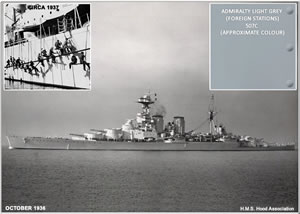
Above: Hood in AP507C, 1936.
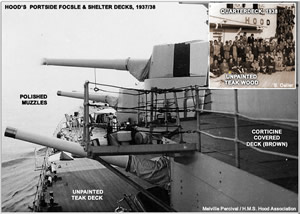
Above: Hood's decks,1937/38.
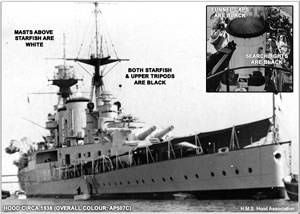
Above: Details of Hood's Mediterranean colours.
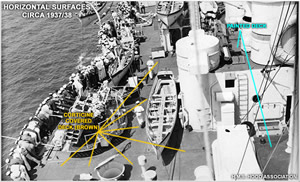
Above - Note the dark horizontal surfaces to
include lower flange of funnel, 1937/38.
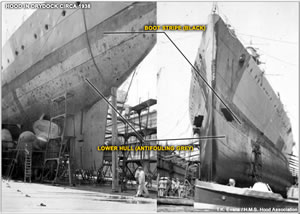
Above -1938. Hood's lower hull being painted grey.
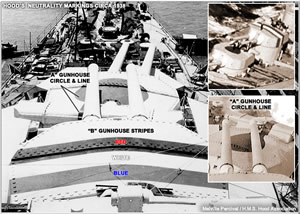
Above: Hood's Neutrality Markings.
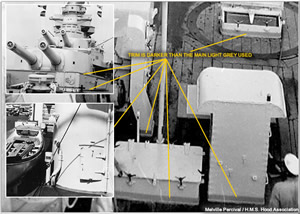
Above: Hood's Paint Trim/Kicking Strip
- Wooden Decks: This includes the focsle (bow), side batteries (the area under the boat deck), the boat deck and the entire quarterdeck (stern). Unpainted teak, very light and bright at this point of her life (due to scrubbing and sun bleaching). Sovereign Hobbies Colourcoats C01 Teak is a good match. One could also use Tamiya XF-78 Wood Deck Tan as base and highlight as necessary. Various metal deck fittings such as fairleads, vents, skylights, hatches, etc., would be hull colour, but others, such as bits and bollards, would be black. We've covered our recommended paints for wood decks earlier in this article.
- Bridge decks: As built, the bridge decks were covered with corticene/corticine, a cork-based linoleum of a brown hue (described earlier in this article). This remained in place on the bottom two decks for her entire career. We do not know what was used for the upper bridge decks that were expanded or added later: its quite possible/likely that these remained covered with corticene. There is a chance that some may have been partially or entirely coated with a non-slip coating such as semtex (a paste-like substance that hardened into an extremely gritty coating). There is also a chance that Navy non-slip paint could have been used.
- Forward and outer portions (un-planked) of Shelter Deck/Boat Deck: These decks were covered in corticene. Periodically, matting was used around some guns.
The deck was widened/expanded in December 1937. Its documented that decking under guns in his area were covered with Semtex (described earlier in this article). We do not know the exact colour of semtex used aboard Hood, but the 1939 colour film suggests it may have been brown or dirty grey ...the actual colour of semtex is difficult to discern as it was difficult to clean and known to become quickly stained and dingy). We assume the same colour was continued to be used through continuity of practice (but we do not know for certain).
- Painted Horizontal Surfaces (Deck Houses, Large Vents, Searchlight Platforms, etc.): Some horizontal surfaces (those that were not exposed to foot traffic) were painted hull colour. Other areas (turret tops, top of conning tower, etc.) were painted dark matte grey. The horizontal areas that were exposed to foot traffic (Searchlight platforms, etc.) are known to have been coated with a darker toned medium. Some have interpreted this as being dark grey (in keeping with perceived/assumed Royal Navy practice), but the 1939 colour film shows that these areas may actually have been painted brown in a tone similar to corticene (or possibly a Van Dyke brown). We also see a similar brown used on one or two contemporary models from the mid 1920s/30s (to include one built by renowned model maker Norman Ough, who was meticulous with research). We assume the colour remained brown during the Spanish Civil War period through continuity of usage. As such, areas such as the searchlight platforms and "Aunty" pom-pom's bandstand were either corticene, dark brown or dark grey (WW2 Dark Grey Non-Slip Deck Paint). This author leans towards brown through continuity of use.
- Foremast: Lower portion of the tripod was hull colour (as was the actual Spotting Top). The upper portion of the foremast was seen painted in two primary ways - first (1936), it was black starting at a point level with the searchlight manipulating platform and going upward and including the underside of the starfish; second (1937 onwards), it was black starting from a point level with the top of the Air Defence Platform. It was also occasionally just hull colour. More often than not, the upper portion was black though. The foretop mast above and behind the Spotting Top was painted white.
- Mainmast: This was usually black from top of starfish extending down to the point where the three legs of the tripod base met (level with funnel tops). There are known instances, however, where the starfish was painted hull colour, albeit briefly. This area often had a white stripe which encircled it. Sometimes it encircled all three legs, sometimes only the aft legs (consult photos of the ship in your preferred timeframe to be certain). Mast tops (starting from where the masts rose up from the starfish) and gaffs were painted white to avoid standing out on the horizon.
- After Searchlight Platform (steel): Decks painted dark grey, MS3 or possibly even brown (corticene or similar colour paint). Vertical surfaces were hull colour. There were large square windows which surrounded the lower rear walls of this structure. These were usually covered with stiff canvas (also painted hull colour).
- Searchlights: Black or dark grey for most of her time in Pattern 507C.
- Funnels: Hull colour uptakes with very top "flange" and cage in black. The lower base flanges were painted dark grey (same colour as metal decks). This can be seen in the photo to the right (dark horizontal surfaces)
- Main Guns: Hull colour (turret sides, rangefinders and barrels). The ends of the 15" gun barrels were emery polished to a bright metallic sheen during peacetime. Blast bags were bright white canvas. The colour of the turret tops/roof plates for turrets A & B was AP507C. The turret top colours for the rear two turrets, X, & Y, seems to vary somewhat. We've seen photos where the tops were the same light AP507C grey as the sides. We've also seen photos where the turret tops were a darker grey.
- Other Guns: Other guns were hull colour (with the exception of the brass and black coloured pom-pom and machine gun barrels). It should be noted however, that we have seen some photos showing 5.5" guns with dark barrels. This did ultimately change to hull-coloured barrels though Secondary gun muzzles were also commonly polished to a bright metallic sheen during peacetime.
- Cranes/booms: Main derrick was definitely hull colour. It would appear that the other derrick booms and various boarding and hoisting booms were unpainted natural wood.
- Ladders/Side Edges: The stairs/ladders leading to the Admiral's area just forward of "X" turret, had unpainted wooden hand railings. The edges of the bulwark along the ship's sides was unpainted wood.
- Waterline: The boot topping was glossy black and about 8ft tall. Please see the comments made earlier in this article.
- Below Waterline: Everything under the waterline, to include the propeller shafts and rudder were confirmed to have been in Peacock & Buchan's anti-fouling grey (which was an unspecified grey over a slate-coloured undercoating) while she was assigned to the Mediterranean Fleet. This colour has been confirmed from various D495 Reports of Docking contained in ADM 136/13 (the ship's books). Learn more about Hood's underside colour here (link to Sovereign Hobbies).
- Detailing Suggestion: Although she tended to have her bottom re-coated annually, the coating did get very worn over the course of the year. As a result, unless you are modelling Hood as "freshly painted" you might want to slightly lighten and/or weather the underside with a bit of slate grey or even black (to simulate her protective undercoating being exposed as the antifouling wore away). You can also add worn spots as well as chipping, barnacles and sea grasses if desired.
- Boats: For information on life boat colours, see Section IV, "Boats," near the end of this article.
- Special Notes for Pattern 507C:
1. During Hood's involvement in the Spanish Civil War, she wore two markings on the roofs of her two forward 15" gun houses:
- "A" Gun house- Hood wore a dark coloured circle and line on the roof of this gun house. This can be seen in turret photo to the right. The exact official purpose of this marking is unknown. It seems likely however, that it was an aerial recognition marking to indicate her nationality and flagship/squadron status. This is supported by the recollection of at least one former crewman (VADM Louis Le Bailly) who recalled it as being a "roundel" marking similar to that on British aircraft. The line emanated from the rear of the circle and passed across the top of the gun house director "wing" just a bit left of the centreline. The colour of the circle and line is unknown (though if VADM Le Bailly was correct, it would likely have been red and/or blue). Based on comparisons to the stripes she wore at the time, the colour of the circle and line seem similar to the blue band in her nationality markings (more on these below). She wore this marking throughout her time with the Mediterranean Fleet.
- "B" Gun house- Hood wore (from front to rear) red, white & blue stripes across the roof of this gun house. The exact colour sequence has been a point of debate, but crew recollections and other documentation verify that the order was indeed red, white and then blue. This can also be seen in the turret photo to the right.
2. Anchor cables were generally painted white (we have seen some photos in which they are a darker colour though). The anchor cable capstans and hawse pipes were painted hull colour (Pattern 507C), but the actual anchor cable plates (that the chains ran along/sat upon) were dark grey or black.
3. The ship's name was polished brass.
4. In various areas trim (kicking strip) was painted in a darker colour (see the photo to the right). The exact height is estimated to be around 6 inches. Examples of this are along the edges of the breakwaters and as a strip of paint along the lower portions of bulkheads/walls (similar to moulding one sees where floors and walls meet). The exact colour is not known, but based on recollections, it could have been black or darker grey. Of course, at even the most common modelling scales, one would probably not see this trim effect.
5. Weathering did of course, occur, but was usually minimal. She was frequent repainted and was particularly "smart" and shiny at this point in her career (except during some of her longer cruises). More on this below.
:
III. January - Mid-May 1941: Variation of Dark Grey (Home Fleet)
From January to mid May 1941, Hood temporarily wore a multiple coloured/shaded paint scheme. For the most part, the ship was painted in overall Home Fleet Grey, with the following exceptions:- A Turret & Gun House- This was notably lighter in shade than the bulk of the ship.
- B Turret & Gun House and Spotting Top- These appeared darker in shade than the bulk of the ship.
Again, the rest of the ship appears to have been painted a uniform dark grey. We're not certain what the reason for this temporary "paint scheme" was. Its not clear if this was a test, an aborted colour scheme change (i.e., camouflage test), or simply mismatched paint work. It is known that battle cruiser Repulse has been painted in an alternating light-dark scheme during this timeframe. Perhaps Hood nearly did likewise. We will likely never know
All we know about this variation is that it was only seen in photos from Spring 1941 and that it was no longer in use when the ship sailed to find Bismarck.
IV. As Sunk (Mid-May 1941): Dark Grey (Home Fleet)
The last documented painting of Hood took place on 12 May 1941 (per the journal of Midshipman Philip Bucket). The ship was returned to her usual overall Home Fleet Dark Grey scheme. It is possible that additional painting took place between then and the time the ship left to engage the Bismarck. This would not be uncommon as the ship's paintwork was frequently cleaned and touched-up during times spent in port. As the log was lost with the ship, there is no way to determine the last day she was painted. There are, fortunately, photos of the ship en route to engage Bismarck which provide a very good idea as to the state of the paintwork. What is known is that the previous two toned look was abandoned in favour of a uniform grey.
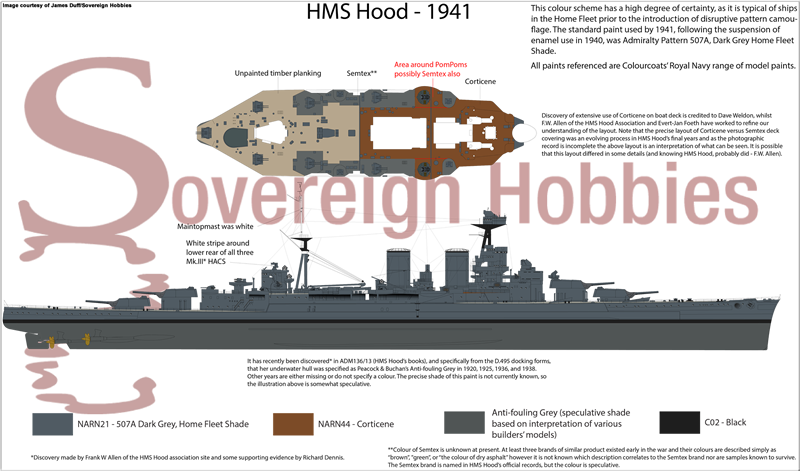
Above- Sovereign Hobbies' excellent colour reference for Hood as-sunk. Click to enlarge and/or visit their website to learn more
Suggested paint match: The following are matches for the Home Fleet dark grey used at this point in time (exact or fairly close directly from the bottle). This list is alphabetically sorted and contains both enamels and acrylics. You may be able to find some of these locally or through a preferred retailer of your choice:
- Lifecolor Admiralty Dark Grey 507 A (UA631)
- Sovereign Hobbies Colourcoats NARN20 - 1936-1943 Home Fleet Grey 507A / 507B 13% RF or Sovereign Hobbies Colourcoats NARN21 - 1936 to early 1950s - Home Fleet Grey 507A / G10 10% RF (best possible match)
- Testors Model Master 4879 - 507-A Dark Gray R.N. (acrylic)
- Testors Model Master 2169 - 507 A Dark Gray R.N. Semi-Gloss 1/2oz (enamel)
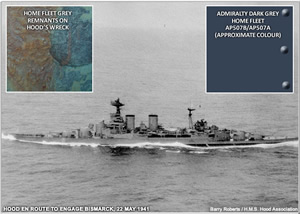
Above - Hood en route to fight Bismarck, May 1941.
She's shown here wearing AP507B paint.
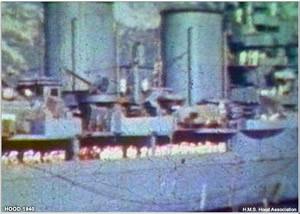
Above/Below - Colour images of Hood circa 1940.
Her colours are a bit off due to the film stock.
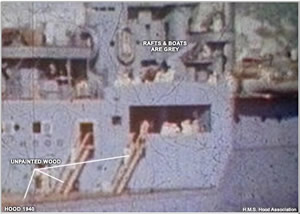
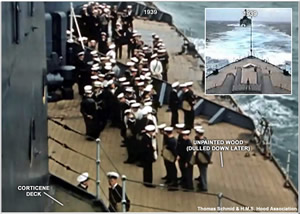
Above- A view of Hood's unpainted focsle teak
decking in mid 1939. Note the dingy colour of the corticene shelter deck.
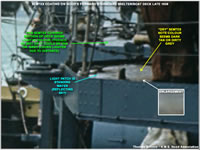
Above- A view of Hood's Shelter Deck. This shows
an area confirmed to have semtex.
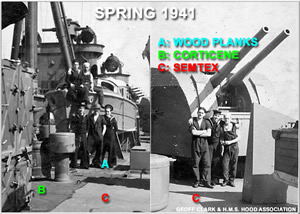
Above- A view of Hood's amidships Shelter Deck, 1941.
This shows wooden planking (aft), corticene inboard
and semtex outboard.
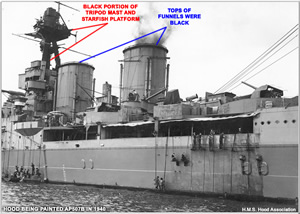
Above- Hood being painted in 1940.
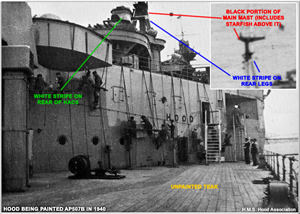
Above- Painting the ship in 1940. Note the
unpainted wood planking.
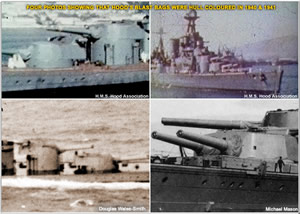
Above: Hood's 15" Gun Blast Bags in 1940/41.
- Wooden Decks: This includes the focsle (bow), side batteries (the area under the boat deck), the boat deck and the entire quarterdeck (stern). These were a dull teak colour with a "muddy" hue. Hood's wooden planked decks were never painted, but its quite likely that they were deliberately dulled-down (but not stained/darkened) after the start of the war (1940 onward). The deck still looked like wood, just not as bright as during peacetime years. For a close colour, we suggest using a colour such as Floquil Mud, or Old Concrete. One could also darken as Tamiya XF-78 Wood Deck Tan. Another option is a replacement wood deck veneer (though be mindful that these are generally pretty light in colour and really should be darkened). As for the various deck fittings, some items (hatches, skylights, breakwaters, vents, etc.) would be hull colour, but others, such as bollards, would be black.
- Bridge decks: The lowest two decks were still covered in corticene. The colour would be somewhat dull and dingy. The upper bridge decks may have been covered with corticene, weathered semtex, dark grey non-slip paint or some combination thereof. We don't know the exact covering in use on the topmost bridge decks at this time. If painted, the standard dark grey non-slip paint would likely have been used. An exact match for wartime non-slip paint would be Sovereign Hobbies Colourcoats NARN23 - WW2 Dark Grey Non-Slip Deck Paint
- Forward and outer portions (un-planked) of Shelter Deck/Boat Deck: There is some evidence to suggest that the deck was covered with a combination of both corticene and semtex at the time of Hood's loss. It appears that the outer areas (under the UP launchers and forward 4" guns) had the semtex, but the area inboard (around the funnels) retained corticene. The colour of the semtex used is unknown (only three colours were in use at this point in time...grey, brown and green), but the last confirmed colour coverage of the ship (1939) suggests it was dirty grey or brown/tan. We assume they'd have continued to use the same colour going forward (but there is no guarantee of this). This seems to fit with the last photos taken aboard the ship as they show the semtex areas to be lighter in shade than vertical painted surfaces and areas with corticene.
- Painted Horizontal Surfaces (Deck Houses, Large Vents, etc.): Some horizontal surfaces (those that were not exposed to foot traffic) were painted hull colour. Other areas (turret tops, top of conning tower, etc.) were painted a dark matte grey. The horizontal areas that were exposed to foot traffic would likely have been coated with semtex or possibly non-slip paint. The exact colour is unknown- we had previously assumed these areas were dark grey (in keeping with perceived/accepted Royal Navy practice), but the 1939 colour film suggest that at least some of these areas may have been painted brown in a tone similar to corticene or Van Dyke brown. We do not know if the colour changed by 1941. As such, areas such as the searchlight platforms and "Aunty" pom-pom's bandstand were either dark brown or dark grey (WW2 Dark Grey Non-Slip Deck Paint).
- Foremast: Lower portion of the tripod was hull colour. The upper portion of the foremast (starting from a point level with the top of the air defence platform and funnels and going to the top surface of the starfish) was black. White fore topmast (before it was taken down in 1941).
- Mainmast: The main portion of the tripod base was painted hull colour.The place where the three legs of the tripod met up to an including the starfish platform were black. The bottom of this black portion was inline with the tops of the funnels. This area also had a white stripe which encircled the aft two legs. Mast tops (starting from its base aft of where the three tripod legs came together) to include the flag gaffs were painted white to avoid standing out on the horizon.
- After Searchlight Platform (steel): Sides were hull colour. Decks were either anti-slip dark grey or possibly dark brown (per the 1939 colour film). The nearby pom-pom bandstand was painted more or less the same. The exact colours are unknown.
- Searchlights: These appear to have been more-or-less hull coloured. The decks and interior bulwarks adjacent to them them appear to have been either brown (per the 1939 colour film) or possibly very dark grey by 1941. The exact colours used are unknown.
- Funnels: Hull colour uptakes with very top "flange" and cage in black.
- Main Guns: Hull colour (turrets and barrels). Note: The ends of the 15" barrels were finally painted over (for camouflage purposes). Blast bags were the same grey as the hull. They were NOT plain canvas nor white! See the photo to the right. The turret tops may have been painted with the dark anti-slip grey (its not entirely clear if this was done aboard Hood at this time).
- Other Guns: Other guns were hull colour (with the exception of the brass and black coloured pom-pom and 0.5" machine guns). Exact colour of UP rocket holder/containers is uncertain - the metal mesh was either painted hull colour or left a dull stainless steel shade. The colour footage of Hood shows the UPs to be a bit darker than AP507B and to have a metallic sheen. This is highly suggestive of them being a dull stainless steel colour.
- Cranes/booms: The main derrick (attached to the main mast) and the booms mounted amidships port & starboard were definitely painted hull colour. There were other booms (located in clusters of 3 on the sides of the forward superstructure) that were indeed plain wood. This has all been proven by the colour wartime footage of Hood from late 1940.
- Ladders/Side Edges: The stairs/ladders leading to the Admiral's area just forward of "X" turret, had unpainted wooden hand railings. The edges of the bulwark along the ship's sides was unpainted wood.
- Waterline: The boot topping was glossy black and about 8ft tall. See the comments made earlier in this article...but if weathering, also pay attention to the lower portion of the boot topping. It would have been very rough due to painting difficulties and erosion caused by wave action.
- Below Waterline: Surviving D495 Reports of Docking contained in ADM 136/13 (the ship's books) confirmed that everything under the waterline, to include the propeller shafts and rudder, was coated in Peacock & Buchan's anti-fouling paint (which was only supplied in grey or black). While there is some anecdotal evidence that Hood may have had a black underside around the time of her loss (namely observations of the bow as the ship sank), photos taken as late as 22 May 1941 as well as footage of the wreck itself show the underside colour to be slightly lighter than the black boot topping. This, combined with previous use, strongly suggest her bottom was coated in Peacock & Buchan's anti-fouling grey. We cannot conclusively rule-out black though. Learn more about Hood's underside colour here (link to Sovereign Hobbies).
- Boats: For information on boat colours, see Section IV, "Boats."
- Special Notes for Hood's Appearance As Sunk:
1. After being repainted in this shade, Hood continued to wear a dark coloured circle and line atop the roof of "A" gun house. Our best guess is that this was possibly a subdued roundel. This of course, has not been confirmed. Whatever the marking was, it appeared to be a bit less crisp than earlier, but still clearly visible at the time of her sinking. Click here to view a photo of the marking.
2. White markings were located on the lower rear sides of each HACS Mk III* director (extending from the sides just aft of the rangefinder arms and going all the way around the rear and reaching as high as half way up the director structure). This marking was on all three HACS directors (two on the bridge and one aft). Click here to see a photo.
3. Hood was extremely busy and frequently at sea during her last months. Despite this, she was painted shortly before her loss. As such, the weathering would note have been extremely pronounced. So, we recommend employing some reasonable light weathering (bow wave chipping, the aforementioned weather of her boot topping, streaking from soot, rust and salt/spray effects on focsle and forward quarter deck, etc.) would be beneficial. More on this below.
4. If modelling Hood during the Battle of the Denmark Strait, be sure to use one Battle Ensign. This was an extremely large version of the White Ensign (@24ft in length). This was flown from the large lower flag gaff on the mainmast starfish. Note: British warships commonly flew multiple ensigns during battle (a tradition dating from the days of sailing ships). In the case of Hood however, it is reported (by survivor Ted Briggs) that she flew just one ensign.
5. The ship's name was painted over in a dark grey or possibly black. For scale purposes, we recommend using dark grey.
6. There is conflicting information regarding a "kicking strip" for the ship as sunk.
7. Anchor cables were dark grey or possibly black. The anchor cable capstans, anchor cable plates and hawse pipes were painted hull colour.
Fortunately, Hood was photographed (by aircraft) en route to engage Bismarck. The aerial photographs show that the ship had been repainted in a an overall Homefleet Dark Grey (see section IV above). One of these aerial photos is included below.
Below-
22 May 1941. H.M.S. Hood is en route to her disastrous engagement with Bismarck and Prinz Eugen. The grey areas of the ship are now uniform.
Note how the area below the waterline is lighter in shade than the waterline boot topping itself.

- Sailing boats (42' launch, 36' sailing pinnace, 32' cutter, 30' gig, 27' whaler, 16' dinghy):
- Hull colour- same as the ship's hull; Interiors- white (area under gratings i.e., bottom sometimes painted dark grey);
- Cappings and rubbing strakes- bare wood;
- Masts and yards- varnished wood;
- Thwarts, pillars and oars- unpainted wood.
- Note: Oars were always stored in the boats in a forward facing position (blades towards the bow).
- Steam boats and motor boats (50' steam pinnace, 45' steam pinnace, 45' and 35' Admiral's barges, 45' motor launch, 35' motor boat, 35' fast motor boat, 30' fast motor boat, 25' fast motor boat, 16' motor dinghy):
- Hull colour- Prior to World War Two, these boats were all painted navy blue with white bottom and white cabins (reddish-brown stained wood deck and cabin sides but white roofs for the Admiral's barges). Note: We understand that commanding admirals' barges were usually painted green. Of course, in the case of Hood, veterans who worked on the barge recalled it being blue. Colour footage also suggests blue. Additionally, although there was a commanding admiral aboard Hood, he was not always the senior admiral. Sometime after the start of the war (sometime during 1940 or 1941), the 35 ft fast motor boats retained their white cabins and white bottoms, but had their hulls painted the same colour as the ship's hull. The smaller motor boats as well as the Admiral's barge appear to have remained in the navy blue, white and stained wood colour scheme. Photos from 1940 and 1941 show dark hulls (though its possible, if unlikely, they were painted dark grey before the final mission).
- Cabins- white.
- Decks- wood or corticene (colour footage shows a rich reddish-brown colour). Note: the Admiralty ordered corticene to be removed from motorboats due to a slipping hazard, but this was probably not carried out aboard Hood.
- Interiors- white and natural wood
- Rubbing strakes- natural wood.
- Some of the small motor boats as well as the Admiral's barge were normally canvas covered. The canvas was generally a light colour in peacetime and grey during wartime.
- General: All boats, with the exception of the Admiral's Barge, wore the ship's badge on both sides of their bow. The Admiral's Barge had a painted flag on each side of its bow (a Rear-Admiral or Vice-Admiral flag depending on the commanding admiral's rank). At times, Hood's boats were often (though not always) covered by canvas when not in use. The canvas was light in colour during peacetime and darker in wartime.
- Rafts: All Carley Floats were definitely Home Fleet dark grey during the wartime years (proven by colour footage). The shade would be the same as that of the ship's hull/superstructure. The floats appear to have been be roughly hull colour during peacetime years as well. Hood did not carry yellow floats (we only mention this because we've seen numerous models where people chose to paint the rafts yellow). Hood carried a variety of small flotation devices as well- things such as life rings (approximately a dozen that were white and red plus some that were black) and towards the very end of her career, 3x3 foot Denton rafts (light grey, the exact shade of which is unknown). The exact placement of these rafts is not known (though we do know that there were many clustered atop the structure between the funnels and below deck along the side openings/ former location of the 5.5" armament).
Incorporate "Scale Effect": The colours used on a model or in artwork would not be as concentrated and therefore not as dark as on the full size ship as seen from the same exact distance. Technically, you are viewing the model/artwork "from a distance"- atmospheric effects would cause the model/painting to look a bit lighter than the actual ship would have appeared up close. So, be sure to lighten the darker colours just a tad with white or light grey. Of course, be sure not to overdo and make it too light (which is very easy to do). Use just a tiny bit of the lighter colour and it should work out fine.
A number of firms manufacture paints that are exact or close matches to the shades mentioned here. We realise that some of you would still prefer to "mix your own" though. We recommend consulting resources such as the in-depth Royal Navy paint research presented at Sovereign Hobbies or the original Admiralty records.
Don't Automatically Overdo Your Weathering: Its true that Hood, like any ship, did have periods where her paint became heavily worn and she resultantly looked a bit worse for wear (sometimes minor, sometimes quite heavy); You'd see worn/chipped paint along the bow/hull (from wave action) as well as numerous small streaks from weather, soot, salt, rust and and so forth. The wood of the focsle and quarterdeck would also show some degree of weather (salt) at times. Of course, this would have been taken care of as soon as possible. Another area to remember is her lower hull. This would have shown signs of weathering and fading,
They key to weathering is not to overdo it if modelling her in peacetime. This is especially so if modelling a smaller sized model. We only mention this because many modellers seem to overdo their weathering by adding tons of rust and gigantic grime streaks to their ship models. It may make the model look more interesting, but its often "over the top" and not historically accurate. Don't overdo it with Hood; a little weathering and streaking for effect is fine, but she should not be dripping rust from every anchor, life rail stanchion and bollard! During the inter-war years she was a prima donna/showpiece and the symbol of the Navy, not a garbage scow! Try not to overdo it.
Are You Modelling Hood in Port or at Sea?: Depending on "when" your Hood is depicted plus, "who" is command, "where" she is and and "what" she is doing, there may be some slight variations in her general configuration for you to consider. The first thing to consider is when which will then tell you who was in command. From there be sure to use the correct flag (either Rear-Admiral or Vice-Admiral). If modelling Hood prior to January 1941, the admiral's flag should be flown from the foretop mast. If you're modelling the ship as in 1941, the flag was flown from high above the main mast.
In Port: Whilst in port, she might be flying a Union Jack from her bow jack staff (the only time it is referred to as such) and White Ensign from her stern. She might also have one or more anchors deployed and/or shackled. She would also have her various stairways deployed - two forward (abreast the bridge) leading from the focsle deck up to the shelter deck and four aft (near the ship's name) leading from the quarterdeck up to the enclosed focsle deck). There may also be boarding ladders positioned along the ship's quarterdeck. It was also common for her large side booms to be swung out in port. Her boats would possibly be uncovered (canvas removed) and even deployed. Her upper main mast (and foretop mast) may be retracted (depending on the location and if she had to pass under tall bridges).
At Sea: Hood would not have flown a jack. Both flag staffs were usually removed and stowed (there were exceptions for short sorties). Her White Ensign would be flown from the mainmast jack staff. Her anchors were obviously retracted and her various stairways (the four large aft ladders and the two forward side ladders) would be dismantled/broken down and stowed.This last part will actually save you a fair bit of work as you would not need to prepare these very prominent ladders. During wartime she might stream paravanes (and zig-zag if you wish to build a sea diorama). During combat, her lower rails would have been lowered. Lastly, at sea, her upper mast(s) would have been elevated to full height.
Happy Modelling! Please send us some photos for our Models Gallery!
